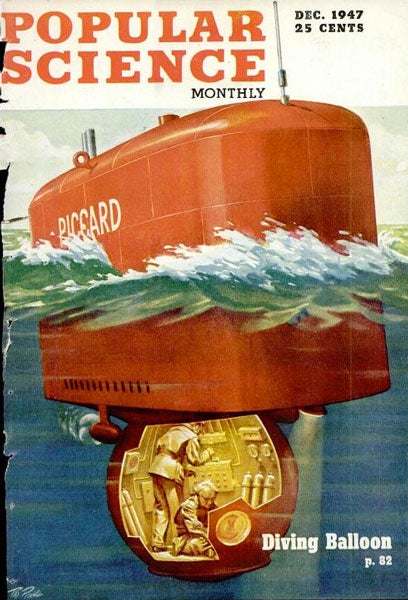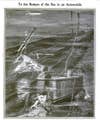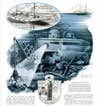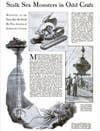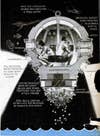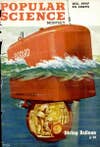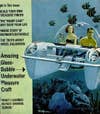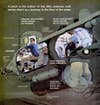While touting space as the next great frontier, we tend to forget that our oceans encompass domains that might as well exist on other planets. Like outer space, the deep sea isn’t an easy place to access, but explorers reared on Jules Verne and tales of the giant squid couldn’t resist the challenge of mapping Earth’s most alien habitat. To that end, innovators like aqua-lung inventor Jacques Cousteau, Swiss physicist Auguste Piccard, and aviation pioneer Edwin Link built submersibles fit for the long and treacherous task. As Piccard once said, “Exploration is the sport of the scientist.”
Click to launch the photo gallery.
By definition, submersibles lack the autonomy, power, and size of submarines. Most of the vehicles covered in this gallery couldn’t function unless they were tethered to a surface ship. While Edwin Link dreamed of using submersible to facilitate week-long “camp outs” under the sea, these vehicles were barely equipped for comfortable living. But for the purposes of exploration, leisure, and even undersea farming, they were perfect (well, as perfect as technology back then would allow).
Appearance-wise, early submersibles shared more in common with land vehicles than military submarines. Early diving cars were squarish, had four wheels, and lacked windows. One even came with a large crane for harvesting sea sponges. This all changed in 1928 when Otis Barton convinced naturalist William Beebe that a small spherical vessel was best suited for resisting the ocean’s crushing pressure. Six years later, Beebe and Barton set a diving record when their Bathysphere descended 3,028 feet, making Beebe the first marine biologist to study deep-sea wildlife in its natural surroundings.
Naturally, the Bathysphere’s renown drove Beebe’s peers to emulate his success. Auguste Piccard, who had previously set an altitude record while ballooning, developed an interest in adapting balloon technology for undersea vehicles. The result? A spherical cabin suspended from an enormous buoyancy device containing 10,000 gallons of aviation gasoline. Piccard’s work reaped an incredible reward just two decades later, when his son Jacques Piccard and Lt. Don Walsh became the first (and so far, only) men to reach Challenger Deep, the deepest known point in the world’s oceans.
Click through our gallery to read about the Bathysphere, the “U-Drive U-Boat,” and other submersibles from decades past.
Diving Car: April 1920
It’s not every day you come across a submersible with wheels, but this steel diving craft was billed as more of an underwater car than a miniature submarine anyway. This invention not only transported divers to the bottom of the sea, but it provided them with cots, benches, tools, oxygen-filled tanks, pressurized acetylene, and a searchlight to guide their work. After the craft finished its descent (with help from a scow and a heavy crane), the divers could drive it using a built-in motor. As you can see on the image at the left, rear wheels used treads to ease the task of driving along the muddy ocean floor. Read the full story in [“To the Bottom of the Sea in an Automobile”
Undersea Farming Sub: March 1933
Simon Lake, famed American submarine builder, spent years working with the Austro-Hungarian Navy, the Imperial Russian Navy, and the U.S. Navy. In addition to making military contributions, he worked on the 22-foot Explorer, a “baby submarine” designed for undersea farming and exploration. Above the surface, the Explorer resembled a “pair of milk cans on a raft,” but when submerged, it could actually harvest $3,000 to $4,000 worth of sea sponges, clams, and pearl oysters per acre. Not bad for a four-wheeled pleasure craft incapable of working independently from its mother ship. Onto the specs: the Explorer could descend 300 feet while tethered to a 500-foot cable, could accommodate a crew of two men and two passengers, and received air from a hose attached to the mother ship. Occupants would communicate with the surface by telephone. It drove along the ocean bottom using 30-inch iron wheels. Unlike its more conventional counterparts, the Explorer came with a crane for harvesting and depositing sea sponges into a large basket lowered into the ocean. Propellers near the front wheels would gather oysters by gently sifting the mud beneath them, thus preventing damage to their shells. Read the full story in [“Midget Sub to Seek Riches on Sea’s Floor”
William Beebe’s Bathysphere: December 1934
Just months before this article was written, renowned American naturalist William Beebe set a world record for deepest dive in a manned vessel when his Bathysphere achieved a descent of 3,028 feet. He couldn’t do it without the help of engineer Otis Barton, though, who designed the submersible in 1928 after The New York Times covered Beebe’s ideas for a diving craft. Although Beebe initially requested a cylindrical vessel, Barton convinced him that a spherical design was more suited to enduring high pressure. After several alterations, the Bathysphere’s design consisted of a one-inch cast steel globe with oxygen supplied from high-pressure cylinders installed within it. Even a couple of high-profile corporations became involved in the project. General Electric supplied the observation lamp, while Bell Laboratories facilitated telephone communication between the submersible and the surface. After the Bathysphere’s initial dive, Beebe and Barton frequently used it to conduct studies on the deep-sea wildlife, which was almost unheard of just a decade earlier, when submarines could descend a mere 300 to 400 feet. And unlike most of its predecessors, the Bathysphere came with windows. This of course allowed Beebe to observe species in their natural habitat, which he couldn’t have done without traveling in a submersible. Although scientists were initially skeptical about the species Beebe discovered, many of his observations were confirmed once undersea technology grew more sophisticated. Read the full story in [“Stalk Sea Monsters in Odd Craft”
Diving Sphere: October 1938
Inspired by William Beebe’s world-famous dive, Swiss physicist and and record-setting aeronaut Auguste Piccard began to adapt high altitude ballooning technology for his own deep sea submersible. This early concept was intended for an expedition off the Canary Islands, which would ideally reach a depth more than six times what Beebe’s Bathysphere had achieved. Unlike the Bathysphere, which consisted of a globe of cast steel, Piccard’s submersible called for an aluminum-alloy sphere with a ballast of steel balls attached by electromagnetic coils. To maneuver the vessel, the crew would use a control panel to release or draw in sections of the ballast. The sub would also come equipped with technology capable of generating electric shocks (just in case explorers encountered a hostile deep-sea species). While Piccard planned this expedition for 1939, the outbreak of World War II forced him to postpone it for almost a decade. Read the full story in [“New Diving Sphere to Explore the Sea at Four-Mile Depth”
Auguste Piccard’s Bathyscaphe: December 1947
After the war ended, Piccard designed a self-propelled “bathyscaphe” capable of descending more than two miles below the surface. Unlike its predecessor, the bathyscaphe hung from an buoyancy device resembling a large balloon (Piccard was a prolific aeronaut, after all).The device contained seven aluminum cylinders filled with aviation gasoline, which was light enough to offset the weight of the steel sphere underwater. Instead of using steel balls as a ballast, crewmen on the bathyscaphe would drop iron-framed concrete blocks suspended from the buoyancy device by electromagnets. Releasing and retrieving the ballast would be as easy as pressing a remote control. Meanwhile, a surface ship would monitor the submersible’s whereabouts and would use sonar emitted from the bathyscaphe to guide it back upward. Read the full story in [“Piccard’s Submarine Balloon”
Deep Star 4000: October 1962
The Deep Star 4000 was a self-propelled vessel designed by Jacques Cousteau (inventor of the aqua-lung) and built by Westinghouse for undersea exploration. At this stage of its conception, the Deep Star (then called “Deepstar”) was expected to reach a depth of 12,000 feet and accommodate a three-man crew. The vessel had two components: a hydrodynamically shaped outer layer and a spherical cabin six feet in diameter. Deepstar would run on a 24-hour battery and cruise at 24 miles at a speed of 3 knots. Additional components included a television camera, a remote-controlled arm, a two-way radio, and a tape recorder. Deep Star 4000 went on to complete 13 dives between October and November 1967, although its crew almost died on one dive after the vessel’s ascent system malfunctioned at 10,000 feet. Read the full story in [“To the Bottom of the Sea in a Saucer”
Sea Diver: July 1963
During the 1960s, Edwin A. Link, inventor of the flight simulator, planned a series of experimental dives in which his crew would live underwater for a week at a time. Using Link’s Sea Diver, the men would increase their descent for 200 feet, to 400 feet, to 600 feet, and possibly even 1,500 feet below the surface. Not an easy feet when your crew consists of three men squeezed into a submersible just 91 feet long. As if the space and potential dangers weren’t enough, the helium intake would make it hard for the men to communicate intelligibly. So why even send people down there for a week? Link, credited for being the first to use a mixture of helium and oxygen for breathing underwater, told us that he was interested in developing technology that would allow men to accomplish tasks to repairing a telephone cable, installing submarine detection stations, and scouting for oil, manganese, and phosphate deposits. Unlike his colleagues, like Jacques Costeau, Link was more concerned with growing an “underwater task force” than building an underwater village. His Sea Diver might not have been comfortable, but it came with a one-man aluminum diving chamber for independent deep-sea swimming. Read the full story in [“Our Race to the Bottom of the Sea”
One-Man Sub: January 1964
If week-long camp-outs under the sea aren’t your thing, why not take a joyride in the German S-24? While this little submersible could descend a mere 100 feet, it cost just $3,450 to own — not bad for casual hydronauts or marine photographers. The S-24 was also fairly simple to use. Four basic controls would allow you to dive, ascend, regulate speed, turn the fins, and adjust the buoyancy tank’s air-water ratio. Once underwater, you could peek through a clear fiberglass dome capable of withstanding pressure equaling a depth of 350 feet. Read the full story in [“U-Drive U-Boat”
Glass-Bubble Sub: July 1966
Some submersibles were designed for research purposes. Others, like this $10,000 model supported by the U.S. Navy Deep Submergence Program, were created to facilitate a leisurely new pastime: observing marine wildlife without getting wet. The project began in 1963 when the Navy began testing submarines with plastic-coated glass hulls. Navy physicist William B. McLean, who also conceived the Sidewinder air-to-air missile, equipped the glass sphere with a photoelectric control box, a scrubber unit for eliminating excess carbon dioxide, a small oxygen tank, radio, cameras, and comfortable bucket chairs. The sub’s design also called for two 16-foot fiberglass pontoons for holding the sphere in place, as well as two reversible axial-flow pumps that would move the craft at a speed of three knots. Read the full story in [“Low-Cost Glass Bubble Sub for Undersea Adventure”
Deep Diver: July 1967
In 1967, Edwin Link not only built another groundbreaking submersible, he wrote the article about it himself. The 22-foot “Deep Diver,” which he described as a taxi for undersea workers, was the first submersible with an exit hatch. Once the breathing-gas pressure in the machine matched the sea pressure outside, divers could slip out the door without letting water into the craft. Four years later, Link adapted the Deep Diver design to the Johnson-Sea-Link, an aluminum alloy submersible that weighed less than its predecessor. Tragically, Link’s 31 year-old son and a another crew member died in 1973 when their Sea-Link got trapped in underwater wreckage. After the accident, Link dedicated much of his time developing a rescue device that could dislodge trapped submersibles. Read the full story in [“Our First Ferry to the Bottom of the Sea”
